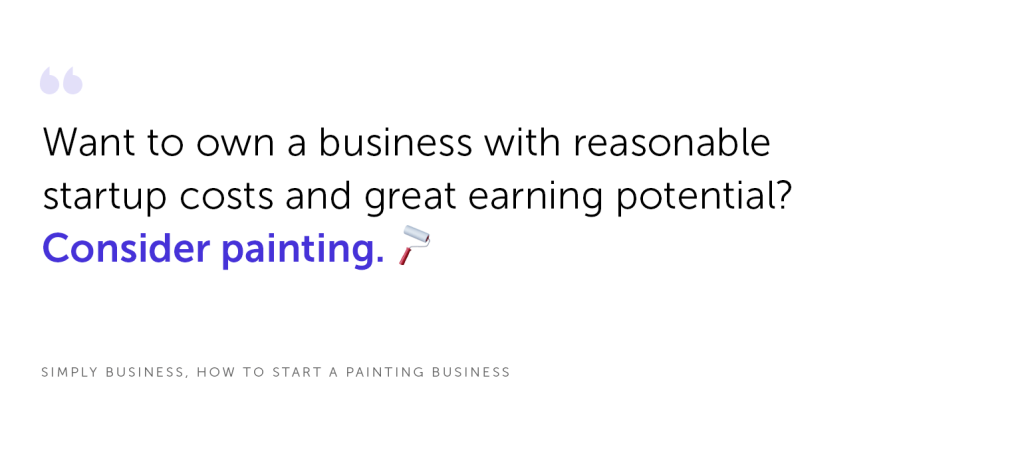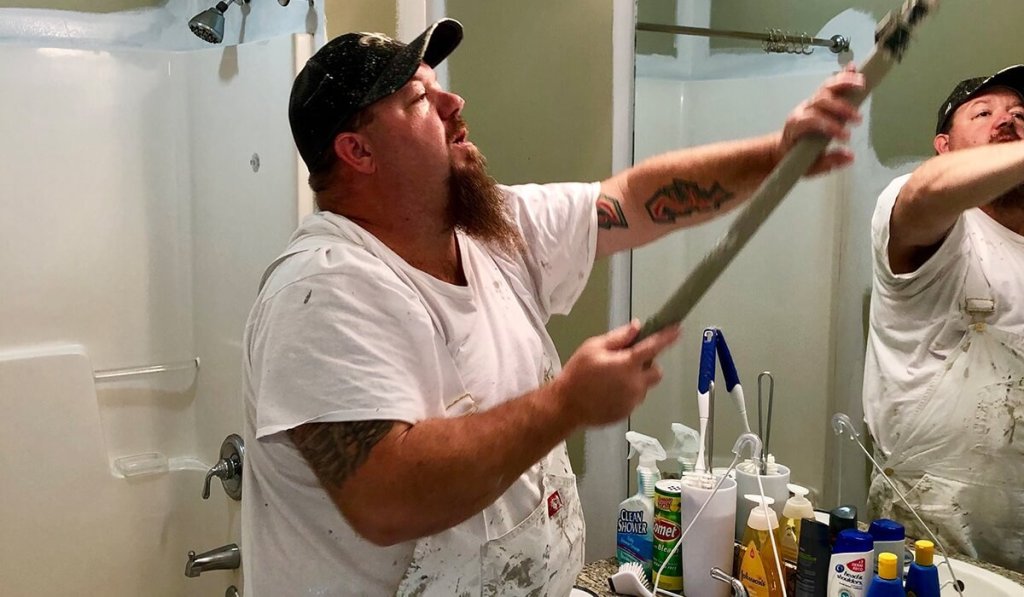So you’ve got a creative streak a mile wide and you like doing something different every day. Have you thought about starting your own painting business?
If you want to own a business with reasonable startup costs and the potential to earn a great living, consider painting. Starting your own business might sound complicated, but it doesn’t have to be. That’s why we’ve put together this step-by-step look at how to start a painting business.
4 Top Tips for Starting Your Painting Business
1. Know the market you’re painting for.
The first thing to figure out is if there’s enough demand for painting in your area. Are there big neighborhoods or commercial areas near you? If you live in a state with frigid winters, will you be able to pick up enough interior work during the colder months?
Be optimistic – but realistic. To start a successful painting business, you should have a solid understanding of the opportunities in your market.
One great way to get these insights is to talk with other painters. You probably know some successful professional painters in your area already. Don’t be afraid to ask them what they think of the market. Is there more business than they can handle? Is it mostly commercial or residential? Interior or exterior? Maybe there’s even an unfilled niche for specialty painting like faux finishes.
Whatever the answers, as a smart entrepreneur, you should have an in-depth understanding of the market before you invest time, money, and energy into your new painting business.
2. Painting practice makes perfect.
Now let’s take a look at your strengths – and what skills you might want to add.
Painting is a detail-oriented, meticulous profession. For many painters, getting to work outside sometimes is a big perk of the job. It can be physically challenging, too – often done from the top of a ladder. And prepping a space for painting can be a workout in itself – think scraping, patching, and sanding before you even pick up a brush.
Learning how to start a painting business has a fun, creative side, too. For instance, can you recommend beautiful color schemes to your clients? Or are you interested in decorative work like stenciling or even murals? Tap into that artistic streak and build creative skills that will keep you in demand.
The best way to become a great painter, of course, is practice! Before you start drumming up business, ask friends or family if they need painting done. Or, to really learn the ropes, go to work for an established painting business for a while. There’s no better way to learn than with hands-on experience.
One other thing: How are your people skills? You’ll be going into homes and businesses, bidding on jobs, talking with clients, and personally handling any concerns that might arise. You want to present yourself as a true professional: friendly, punctual, and considerate of their time and space. If clients like your personality as well as your work, they’ll be excited to recommend you to others.
3. Schedule some office time.
Your first few months will involve a lot of administrative work. It’s an essential step in starting your own painting business, and if you’re thoughtful about it in the beginning, you’ll save time and frustration when you’re busy with jobs later on.
State and local regulations will be different depending on your location. If you’re not sure where to start, visit the Small Business Administration website. Your town office or city hall also should be able to help. Check out their online resources, or plan an in-person visit and write down the questions you want to ask, so you get the information you need in one visit.
Make time to sort out taxes, invoicing, and a few other items. As you get ready to become a first-rate professional painter, you’ll need to do most (probably all) of the following:
- Register as a business
- Get any necessary permits
- Open a bank account
- Buy painting business insurance
- Set up a bookkeeping system
- Organize and file receipts for painting business purchases
- Launch an online presence
- Market to potential clients
We know it sounds like a lot – but don’t be discouraged! We just want you to have all this information at your fingertips, so you can start your painting business with a clear vision. If it feels daunting, one piece of advice is to keep it simple and let experts help where they can.
For example, you’ll want to protect your new business with insurance, and it doesn’t have to be complicated. Work with the experts at Simply Business, for an experience that’s fast and easy.
Remember, a liability policy not only helps cover costs in case of an accident, but it also shows prospective clients you’re a serious professional. Most of all, it gives you peace of mind, so you can focus on the most important thing – your new painting business!
Get Insured in Under 10 Minutes
Get an affordable & customized policy. So you can get back to what matters: Your business.
4. Focus on finances.
So you’ve built your skills and you know there’s demand. Now let’s talk about money.
When it comes to going into business for yourself, you probably have two big questions:
- How much does it cost to start a painting business?
- How much should you charge clients for your painting services?
These are tough numbers to pin down, we admit it. But we can give you a solid idea of the expenses that come with starting your painting business. Let’s spend the next section talking about exactly that!

What You Need to Start a Painting Business + Price Breakdown
Brushes, rollers, and sprayers
For commercial painters, high-quality brushes and rollers are a must. The style you need will vary depending on the job. For instance, a thin, angled brush for window sashes is typically less than $10, while a broader wall brush will run closer to $25 or $30.
Want to get a little more high-tech? Many painters swear by sprayers, particularly for exterior jobs. They’re fast and relatively easy to use. A well-made airless paint sprayers will start at around $200.
Paint
As a rough guide, one gallon of paint will usually cover 350 square feet, and a good brand will cost from $25 to $45 a gallon. Primer, which you might need depending on the surfaces you’re painting, is similar in price per gallon.
While every house is different, you’ll need about 10 gallons to cover the exterior of a 1,500-square-foot home or 2-3 gallons for an average interior room, so plan accordingly!
Ladders
If you’ll be doing interior and exterior painting, plan on having two ladders. An 8- to 12-foot ladder will come in around $100, while a 28- to 32-foot one should cost around $300.
If you’re just pulling in your first job or two, you could always rent interior scaffolds for around $10 per hour.
Dropcloths, tape, and trays
These don’t need to be anything fancy, of course, as long as they get the job done. Budget $100 altogether, though you probably won’t need that much.
Transportation
If you don’t already have a vehicle that can get your equipment to the job site, it’s time to invest. Some painters say they prefer a van because it’s easier to stay organized, and your supplies stay more secure. While a new cargo van checks in at around $30,000, a used vehicle can be a lifesaver for your budget. Shop around – and don’t forget, you’ll also need a ladder rack! Luckily, good ones can be had for between $100 and $200.
Your business license, permits, and insurance
It’s always a little difficult to estimate these costs because requirements vary by city, county, and state. A safe bet is somewhere between $50 and $400.
Marketing materials
Good marketing is essential to new business owners – but when you’re just learning how to start a painting business, you don’t want to fork over a ton of money for this.
Start with a Facebook page for your new company and some painting business cards, and you’re up and running for less than $50. Add a bit more cash for brochures or flyers to hand out, and you can recoup those expenses after your first couple of jobs.
To price your services:
We’ve all heard the saying, “It takes money to make money.” But now that you’ve invested in your new painting business, how much can you make? Your rates should reflect your local economy, of course, so make sure you’re in line with the local market.
Here’s the fun part: On average, painters in the U.S. charge approximately $50 an hour. When you add up labor and materials, you’ll likely be estimating $1,700-$3600 for the interior of a house and $2,500-$3,000 for an exterior.
And if you’re skilled at specialty items like murals? You can ask $800-$1,700 for a single wall, or up your rate to as much as $100 per hour.
No matter what you decide, remember that the rates you set aren’t permanent. Try out a few rates to see what gets you the most projects – and what gets you the painting projects you enjoy most.
Got More Questions on How to Start a Painting Business?
We’ve got some answers. Check out these helpful articles:
6 Reasons Why You Need Painting Business Insurance
How to Bid a Paint Job: A Step-By-Step Guide
